King's Beasts, Hampton Court Palace
The King's Beasts are ten stone statues of heraldic animals, created during the reign of King Henry VIII (1509–1547) whilst married to his third wife Jane Seymour (Queen of England from 1536 to 1537), which sit atop castellated hexagonal pillars on the parapets on each side of the bridge over the moat leading to the Great Gatehouse of Hampton Court Palace in Surrey, England. Each holds a shield of arms and represents the ancestry of King Henry VIII and of Jane Seymour, being heraldic supporters from the coats of arms of various families.

List of King's Beasts
The ten beasts are:
- the lion of England, supporter of the royal arms of England;
- the black bull of Clarence, with a Tudor rose on its shield;[1]
- the yale of Beaufort;
- the white lion of Mortimer;[2]
- the White Greyhound of Richmond;
- the Tudor dragon;
- the Royal dragon;
- the Seymour panther
- the Seymour unicorn;
- the Seymour lion.
Dynastic significance
Clarence, Mortimer, York
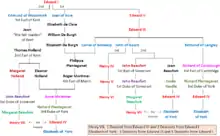
King Henry VIII's mother was Elizabeth of York (1466–1503), eldest daughter and eventual heiress of King Edward IV of the House of York. The descent from Lionel of Antwerp, Duke of Clarence, second surviving son of King Edward III (1327–1377), via the heiress Anne de Mortimer (1388–1411), gave the Yorkist dynasty its claim to the throne. Anne de Mortimer was the daughter and eventual heiress of Roger Mortimer, 4th Earl of March (1374–1398), grandson and heir of Lionel of Antwerp, Duke of Clarence. This made Anne and her brothers potential heirs to the throne during the reign of the childless King Richard II, son of the Black Prince, eldest son and heir apparent of Edward III. In 1399 Richard II was deposed by Henry IV, son of John of Gaunt, 1st Duke of Lancaster, 3rd son of King Edward III, and younger brother of the Duke of Clarence. Edmund Mortimer, 5th Earl of March (1391–1425) (brother of Anne de Mortimer), being a more senior descendant of King Edward III, was thus a dynastic threat to Henry IV, who placed both Edmund and his brother Roger under royal custody. Anne de Mortimer married Richard of Conisburgh (1385–1415), the second son of Edmund of Langley, 1st Duke of York (fourth son of King Edward III). Her son was Richard of York, 3rd Duke of York (1411–1460), Yorkist claimant to the English throne, and father of kings Edward IV and Richard III. The daughter and eventual heiress of King Edward IV was Elizabeth of York (1466–1503), who married Henry Tudor, Earl of Richmond who became King Henry VII on the defeat of Richard III at the Battle of Bosworth in 1485, and became the mother of King Henry VIII, whose paternal grandmother Lady Margaret Beaufort represented the House of Lancaster, being descended from John of Gaunt. Thus in the person of Henry VIII the red rose of Lancaster and the white rose of York, feuding parties in the Wars of the Roses, were united, symbolised by the Tudor rose, combining both colours. One of the King's Beasts, the Black bull of Clarence, an heraldic supporter of the arms of the Duke of Clarence, displays the Tudor rose. Similarly several of the other beasts display arms and badges seemingly indiscriminately and in promiscuous fashion, emphasising the confused union of all these dynasties and competing claims.
Armorials & heraldic badges
| Beast | Image | Shield | Blazon |
|---|---|---|---|
| Crowned lion of England, a supporter of the arms of Henry VIII during the later part of his reign (having replaced the Richmond greyhound), together with the Tudor dragon.[3] |  |
 |
Royal arms of King Henry VIII impaling Seymour, of six quarters:
|
| Seymour panther |  |
 |
Arms of Seymour (ancient): Gules, two wings conjoined in lure or, paternal arms of Queen Jane Seymour |
| White Greyhound of Richmond, a device of the Somerset (Beaufort) family,[4] used as a supporter (with the Tudor dragon) by Henry VIII during the early part of his reign.[5] |  |
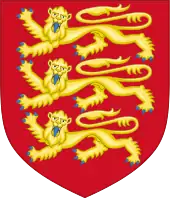 |
Arms of Plantagenet: Gules, three lions passant guardant in pale or, as borne by the Earls of Lancaster[6] (without quarters of France brought in by their cousin King Edward III), ancestors of Blanche of Lancaster, the heiress wife of John of Gaunt, founder of the royal House of Lancaster. |
| Yale of Beaufort | 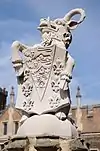 |
 |
Arms of Edward Seymour, 1st Duke of Somerset, eldest brother of Queen Jane Seymour |
| Tudor dragon, a red dragon representing the (pre-heraldic, attributed) arms of Cadwaladr, a seventh-century king of Gwynedd, who was the last Welsh king to claim lordship over all of Britain and from whom King Henry VII claimed descent.[7] Used as a supporter (with the Richmond greyhound) by Henry VIII during the early part of his reign.[8] |  |
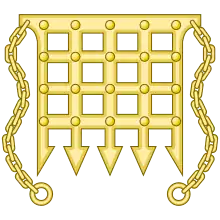 |
Heraldic badge of the House of Beaufort: Beaufort Portcullis |
| Mortimer panther |  |
Royal arms of King Henry VIII impaling Seymour, of six quarters, as on shield held by Lion of England | |
| Black bull of Clarence; the supporters of the arms of King Edward IV were the black bull of Clarence and the white lion of Mortimer.[9] | 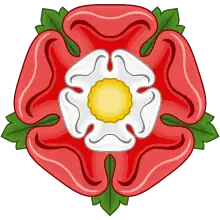 |
Tudor rose | |
| White lion of Mortimer;[10] the supporters of the arms of King Edward IV were the black bull of Clarence and the white lion of Mortimer.[11] |  |
Three-in-one badge of Jane Seymour, bottom to top:[12]
| |
| Royal dragon | 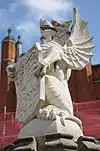 |
.svg.png.webp) |
Royal arms of King Henry VIII |
| Seymour unicorn |  |
Arms of Jane Seymour, quarterly of six, as sinister (femme) side on shield held by Lion of England | |
King's Beasts, St George's Chapel

A larger set of similar sculptures was created at about the same time to adorn the roofline parapets of St George's Chapel, Windsor Castle, but were all removed after 1682 by Sir Christopher Wren, who found them "decayed and dangerous" and suggested replacement with stone pineapples, a fruit then much in vogue.[16] Wren's suggestion was not taken up and the roof remained unadorned for over two centuries until the 1920s when the architect Sir Harold Brakspear (1870–1934) recommended the reinstatement of the heraldic beasts, and submitted his own designs for approval by the Garter King of Arms in 1923. The work was financed by the generous donation of Frederick Minter (d. 1927) of Putney in Surrey, a wealthy building contractor, who at his own cost commissioned 76 new Beasts (each 4 feet 6 inches high) from the sculptor Joseph Armitage. After his death the work was completed by his son the civil engineer Sir Frederick Albert Minter (1887–1976) who as a token of royal gratitude was created by Queen Victoria a Knight of the Royal Victorian Order, awarded for personal services to the monarch. Sir Frederick Minter recorded the work in his 1925 book The Kings Beasts. The new Beasts were installed on St George's Chapel between 1925–8. The Windsor Beasts include the crowned lion of England, the unicorn and falcon of Edward III, the swan and antelope of Bohun, the panther of Henry VI, the Beaufort yale, the white hart and falcon of Richard II, the white hind of Edward V, the dragon of Henry VII, the lion of Mortimer and the Neville greyhound, and are arranged to represent the House of York on the north side and the House of Lancaster on the south, which two factions were united in the person of King Henry VII, the builder of the Chapel.[17] Similar sculptures exist on the Chapel at Hampton Court.

Derivatives
The Queen's Beasts
A twentieth-century equivalent set was made in plaster for display at the Coronation of Queen Elizabeth II in 1953. Known as the Queen's Beasts, these figures are now on display in the Canadian Museum of History in Quebec. Replicas of these in Portland stone are on display outside the Palm House at Kew Gardens, a former royal residence near Hampton Court. The Seymour beasts were omitted, the Queen not being descended from Jane Seymour, whose only son King Edward VI died unmarried. In the Queen's Beasts four new beasts replaced the three Seymour beasts and one of the dragons, namely the griffin of Edward III, the horse of Hanover, the falcon of the Plantagenet and the unicorn of Scotland.[18]
.jpg.webp) Some of the ten Queen's Beasts, made from plaster for the 1953 Coronation of Queen Elizabeth II, on display in the Canadian Museum of History, Quebec
Some of the ten Queen's Beasts, made from plaster for the 1953 Coronation of Queen Elizabeth II, on display in the Canadian Museum of History, Quebec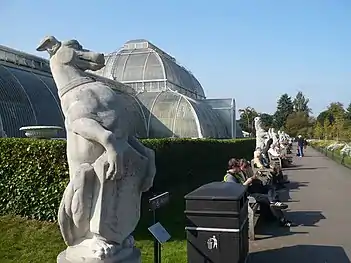 Portland stone replicas of the Queen's Beasts in Kew Gardens, near Hampton Court
Portland stone replicas of the Queen's Beasts in Kew Gardens, near Hampton Court
Tudor Garden, Hampton Court
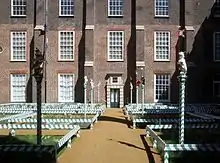
In 2009 to celebrate the 500th anniversary of the accession to the throne of King Henry VIII, a new "Tudor Garden" was created in Chapel Court, Hampton Court, designed by Todd Longstaffe-Gowan.[19] To decorate the garden eight small wooden King's Beasts were carved and painted in bright colours,[20] each to sit atop a 6-foot-high painted wooden column. The historically correct colours were researched by Patrick Baty, paint/colour consultant at Hampton Court.[21] The beasts are of a different design to those on the bridge, based on period drawings in the College of Arms.
Sources
- Thomas Dudley Fosbroke, Rev, Encyclopedia of Antiquities and Elements of Archaeology, Classical and Mediaeval, Vol. 2, London, 1843; quotes extensively from Willement
Further reading
- Thomas Willement, Regal Heraldry: The Armorial Insignia Of The Kings And Queens of England, from Coeval Authorities, London, 1821
References
- see image
- see image
- Fosbroke, p. 758
- Fosbroke, p. 757
- Fosbroke, p. 758
- Fosbroke, p. 756
- Fosbroke, p. 757
- Fosbroke, p. 758
- Fosbroke, p. 757, with "Clare" for "Clarence"
- see image
- Fosbroke, p. 757, with "Clare" for "Clarence"
- Thomas Dudley Fosbroke, Encyclopedia of Antiquities: And Elements of Archaeology, Vol. 2, p. 758
- Fosbroke, p. 755
- Fosbroke, p. 757
- Fosbroke, p. 757
- Clare Rider (Archivist and Chapter Librarian St George's Chapel), F. G. Minter and the King’s Beasts
- Clare Rider (Archivist and Chapter Librarian St George's Chapel), F. G. Minter and the King’s Beasts
- "Statues of the King's Beasts". Beautiful England. Retrieved 10 November 2014.
- Todd Longstaffe-Gowan
- Todd Longstaffe-Gowan
- Patrick Baty ; see images
.jpg.webp)
